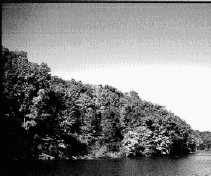FNR-150-W
Cooperative Extension Service
Purdue University
West Lafayette, IN 47907
Forest Policy Issues in Indiana*
by Dennis C. Le Master and Lois E. Rans
The purpose of Forest Policy Issues in Indiana is to
provide a brief overview of public policy analysis as well
as a summary of leading contemporary policy issues in
Indiana relating to forestry.
 Forestry is important to Indiana. Its forests are
strikingly beautiful, productive in terms of wildlife
habitat, and sites for many outdoor recreational
activities. Furthermore, these forests support several
industries manufacturing wood products: hardwood
lumber and veneer at the primary level and wood
furniture and cabinets at the secondary level. Together
these industries comprise one of the very largest
employers in the state.
Forestry is important to Indiana. Its forests are
strikingly beautiful, productive in terms of wildlife
habitat, and sites for many outdoor recreational
activities. Furthermore, these forests support several
industries manufacturing wood products: hardwood
lumber and veneer at the primary level and wood
furniture and cabinets at the secondary level. Together
these industries comprise one of the very largest
employers in the state.
A public policy problem or issue necessarily
precedes a public policy. Policy can be defined as a
settled course of action. A policy can be private or
public. The kind discussed here is the latter Hence, a
public policy is a settled course of action to be
followed by a government body or institution with
regard to an issue.
Policy analysis is an applied academic discipline
which can be defined as the systematic evaluation of
the viability of alternative policies from several
perspectives, strategies for implementation, and the
consequences of adoption. A seven-step process is
often used in conducting policy analysis, specifically:
- Defining the problem;
- Establishing evaluation criteria;
- Identifying alternative policies;
- Evaluating alternative policies;
- Selecting the preferred policy;
- Implementing the preferred policy; and
- Monitoring and evaluating policy
implementation
(Patton and Sawicki)
Rationales for Public Policy
 Several rationales for public policy exist, most
involving some element of market failure. As presented
in contemporary economic texts, market failure occurs:
when public goods are involved, where externalities
exist, in the event of natural monopolies, and under
conditions of lack of knowledge by consumers (Barron
and Lynch; Stiglitz; Varian. Public goods are goods that
cannot be withheld from one individual without
withholding them from everyone, like national defense,
street lighting, or police protection. Externalities are
descriptive of situations in which certain goods or
services are produced and sold privately, and some
people incur costs for which they are not reimbursed-
like someone downstream from a manufacturer who
dumps pollutants into a water course or receive
benefits for which they do not have to pay like
someone who builds a home or locates a business near a
park offering a scenic vista. Natural monopoly occurs
when fixed costs of providing a good are very high
relative to variable costs so average cost declines as
demand increases. Lack of knowledge refers to
situations in which information about a good or service
is not available to consumers resulting in them buying
either too much or too little.
Several rationales for public policy exist, most
involving some element of market failure. As presented
in contemporary economic texts, market failure occurs:
when public goods are involved, where externalities
exist, in the event of natural monopolies, and under
conditions of lack of knowledge by consumers (Barron
and Lynch; Stiglitz; Varian. Public goods are goods that
cannot be withheld from one individual without
withholding them from everyone, like national defense,
street lighting, or police protection. Externalities are
descriptive of situations in which certain goods or
services are produced and sold privately, and some
people incur costs for which they are not reimbursed-
like someone downstream from a manufacturer who
dumps pollutants into a water course or receive
benefits for which they do not have to pay like
someone who builds a home or locates a business near a
park offering a scenic vista. Natural monopoly occurs
when fixed costs of providing a good are very high
relative to variable costs so average cost declines as
demand increases. Lack of knowledge refers to
situations in which information about a good or service
is not available to consumers resulting in them buying
either too much or too little.
A rationale for public policy can also exist when
public consensus exists about some social goal such as
income distribution, education, or aesthetics. For
example, public education is not provided in the U.S.
because of market failure, but because society feels it is
desirable and necessary in a democratic society
There are limits to government intervention in
markets, and they can be called instances of government
failure (Weimer and Vining). It has been convincingly
shown, for example, that majority voting cannot provide
a means of determining collective choices consistently
from individual choices and, at the same time, satisfy
conditions of rationality. In other words, voters are
frequently inconsistent in expressing their collective
preferences. Further, significant problems with
representative government exist which sometimes lead
to government failure such as the disproportionate
influence of organized or special interests, the conflict
between regional interests and national interests, the
short time horizons of elected officials caused by the
election process, and the distortion that occurs in public
policy debates when politicians posture to news media
to gain public attention. Finally, there are bureaucratic
organizational problems associated with government
including:
- limitations in time and expertise necessary
to review and monitor government operations, including
how resources are used;
- lack of competition and its
effect on incentives to innovate;
- difficulty in valuing
output of many government services such as national
security, law and order, and safety; and
- inflexibility in
personnel administration because of civil service
protections and perhaps some affirmative action
programs.
The point is neither the market system nor
government intervention is the complete answer in the
allocation of resources or goods and services. In fact, the
best answer to a question of which is better is "it
depends." And among those things upon which "it"
depends are societal values and goals, the perceived
degree of market failure, and the likelihood of success of
government intervention.
Criteria for
Evaluating Public Policy
Several criteria are often used in public policy
analysis to evaluate policy alternatives, for example:
technical feasibility, economic efficiency, political
viability, and administrative operability (Brewer and
DeLeon; Dunn; Patton and Sawicki) The five that follow
are a version developed by Marion Clawson in the l97Os,
which are fairly well known and accepted among forest
policy analysts in the U.S (Clawson).

- Physical and biological (technical) feasibility: Is
the policy physically and biologically
(technically) feasible? For example, with regard
to forestry, does the policy make biological
sense? Would it have the intended effect?
Would it adequately address the problem?
- Economic efficiency: Are the benefits of the
policy worth the costs, both tangible and
intangible in each case? Has a conscientious
effort been made to minimize the unintended
consequences in the market?
- Equity: Who benefits and who loses? Is it fair,
applying conventional societal standards?
- Social acceptability: Is the policy acceptable to
society in terms of prevailing social values and
goals? To what extent is the policy acceptable
to relevant groups in society?
- Administrative practicality: Does the
implementing agency have the authority to
carry out the policy? How committed to the
policy is the agency? Is it capable of
implementing the policy in terms of staffing,
bugdet, and time? Does the agency have the physucal
facilities, equipment, and other support to implement
the policy?
Table 1. Advantages and Disadvantages of
Generic Kinds of Government Intervention
Kind Advantages Disadvantages
------------------------------------------------------------
General Voluntary No compliance
education participation; mechanism; lacks
programs inexpensive site specificity
Technical Voluntary No compliance
assistance participation; mechanism
programs provides for site
specificity;
comparatively
inexpensive
Insurance or Voluntary No compliance
"cushioning" participation; mechanism;
programs market responsive; modestly
provides investment expensive
incentive by
reducing risk
Regulation Has compliance Mandatory; raises
mechanism; can production costs of
provide for site producers;costly
specificity; effective to enforce;
in achieving unresponsive
minimum to market forces
performance
standards
Taxation Participation in Taxation
or subsidy or tax approach is
subsidization expenditure involuntary;
programs is costly
voluntary; Market
responsive;
provides incentives
Public Targeted; provides Unresponsive to
ownership for long time market forces;
horizons and costly; subject
nonmarket values to the
vicissitudes
of government
funding
Generic Kinds of
Government Intervention
Government intervention as a matter of public
policy can take several standard forms, specifically:
- General education programs, e. g., developing
and offering educational programs through the
cooperative extension service for various
groups, such as forest landowners, by offering
seminars, workshops, and field tours.
- Technical assistance programs, e. g., developing
and offering direct site-specific technical
assistance programs for forest landowners;
- Insurance or "cushioning" programs, e. g., an
insurance program for forest landowners
against forest disease epidemics, insect
infestations, and fires.
- Regulation: directing allocation of resources by
rules or orders issued by the executive authority
of government, having the force of law.
- Taxation or subsidization: offering financial
incentives or favorable tax treatment, e. g.,
government cost-sharing for tree planting by a
private landowner, or financial disincentives
such as a tax on overseas shipment of saw logs.
- Public ownership of resources or production or
goods and services: directing allocation of
resources by direct government intervention in
markets. Government ownership does not have
to be complete. Government may acquire only
those property rights necessary for its purposes
such as the development rights of a tract or the
surface rights.
The foregoing forms of government intervention
through public policy are not presented in a random
order. Instead, they are presented in an order intended
to approximate an increasing degree of intervention
as well as relative cost. While these may comprise two
criteria for evaluating public policy, they are not the only
ones as indicated earlier. Set forth in Table I is a list
of advantages and disadvantages of each form of
intervention.
Contemporary Forestry
Issues in Indiana
Nine issues concerning forestry and forest lands in
Indiana are the subject of current public interest and
debate. They are presented below in alphabetical order in
terms of a description of the situation, statement of the
problem, and alternative policy solutions. Only seemingly
viable generic policy solutions are presented. Other
viable policy solutions are presented, those seemingly
unique to the problem, when appropriate. Because of
limitations in space, the solutions are not presented in
detail, but in abbreviated form.
A no-action alternative-doing nothing-is normally
included among the alternative policy solutions
for any public policy problem, and it should be assumed
for each of the policy issues listed below. Generally,
selecting the no-action alternative would result in exacerbating
the identified problem. On the other hand, the
no-action alternative may occasionally compare quite
favorably to other proposed solutions when subjected to
evaluation criteria such as that described earlier.
Forest Fragmentation
 Indiana's natural forests are fragmented due to
agricultural, industrial, and urban and suburban development.
Timber harvest units, roads, and powerline and
pipeline corridors can also breakup forest areas. Forest
fragmentation tends to reduce biological diversity, defined
as "the variety and abundance of species, their
genetic composition, and the communities, ecosystems,
and landscapes in which they occur" (Society of American
Foresters). Biological diversity is important for economic,
ecological, intrinsic, aesthetic, and legal reasons (Roberts
et al.).
Indiana's natural forests are fragmented due to
agricultural, industrial, and urban and suburban development.
Timber harvest units, roads, and powerline and
pipeline corridors can also breakup forest areas. Forest
fragmentation tends to reduce biological diversity, defined
as "the variety and abundance of species, their
genetic composition, and the communities, ecosystems,
and landscapes in which they occur" (Society of American
Foresters). Biological diversity is important for economic,
ecological, intrinsic, aesthetic, and legal reasons (Roberts
et al.).
Public Policy Problem: Indiana forests are fragmented
and are in danger of becoming more so, adversely affecting
biological diversity of forest flora and fauna in the
state.
Public Policy Solutions:
- Protect forrest lands by zoning. Forest lands could
be zoned so they continue under forest cover.
Nevertheless, zoning is a form of regulation
and would be strongly objected to by some
landowners.
- Provide financial incentives to place and maintain land
under forest cover. Financial incentives for landowners
could be used to protect existing forest
lands, to increase their size, and to establish
forests to lessen the degree of forest fragmentation in the state.
- Acquire key forest lands. Forest lands could be
acquired and placed under public ownership to
increase the size of existing public forests, to
"block up" existing holdings of public forest land,
to reduce forest edge-the transition zone
between adjacent vegetative communities-on
public forest lands, and to provide suitable
vegetative corridors between forests, such as
along water courses. The challenge, of course, is
that land acquisition is expensive. In lieu of
acquisition, development rights could be acquired, which
would lessen the cost of this
approach.
Interstate 69 Extension from
Indianapolis to Evansville
 Renewed interest has developed in extending
Interstate 69 from Indianapolis to Evansville. Such a
project is supported by business interests in Evansville,
the Governor's Office, the Indiana Department of
Commerce, and the Indiana Department of
Transportation, among others. It is opposed by several
activist groups, including Citizens for Appropriate Rural
Roads, Heartwood, the Hoosier Environmental Council,
and Protect Our Woods.
Renewed interest has developed in extending
Interstate 69 from Indianapolis to Evansville. Such a
project is supported by business interests in Evansville,
the Governor's Office, the Indiana Department of
Commerce, and the Indiana Department of
Transportation, among others. It is opposed by several
activist groups, including Citizens for Appropriate Rural
Roads, Heartwood, the Hoosier Environmental Council,
and Protect Our Woods.
The controversy centers primarily around the
selection of the route for the extension. Several have
been proposed, and three have been actively considered.
From a forestry perspective, the issue is the impact of
the extension on forests in southwestern Indiana. To
what extent would it reduce forest lands in the region?
What effect would it have on forest fragmentation? What
effect would suburban development along the corridor
have on forests and wildlife habitat? To what extent
would such development limit forest accessibility for
timber harvesting?
 Public Policy Problem: Extension of Interstate 69 could
significantly reduce forest acreage in southeastern
Indiana and increase forest fragmentation.
Public Policy Problem: Extension of Interstate 69 could
significantly reduce forest acreage in southeastern
Indiana and increase forest fragmentation.
Public Policy Alternatives:
- Construct the extension on a route that minimizes a
reduction in acreage. The problem with
developing such a route is that it would likely
require converting productive agricultural land
into an interstate highway and increase the cost
of the extension.
- Mitigate the reduction in forest acreage by converting
agricultural land into forest land. The problem with
mitigation is that it is costly, and it normally
involves a lengthy transition period before its
positive effects are realized.
Lack of Resource Data
A survey of the forests of Indiana is sporadically
conducted by the federal government with cooperation
and participation of the Division of Forestry of the
Indiana Department of Natural Resources.

The survey is
supposed to be conducted every ten years, but indeed
the last two surveys were conducted in 1967 and 1986,
nineteen years apart. Another forest survey is scheduled
for 1996. Survey data are gathered with respect to forest
land area, including productivity, forest type, and
ownership, and stand-size class distribution, including
tree species, diameter distribution, mortality, net growth,
and removals.
No data are collected on forest health, and spatial
data are inadequate for purposes of making virtually any
inferences about forest dynamics across the landscape.
Furthermore, no data are routinely collected on the
economic aspects of timber such as timber and saw log
prices. Finally, data on the wood products industries are
lacking other than what periodically appears-about
every four of five years in the Census of Manufacturers
which is of little use for making economic development
decisions. The frequent claim that the wood products
industries is the fourth or fifth largest industry in Indiana
is at best an educated guess based on fragmentary and
incomplete data.
Other than birds, systematically collected data on
forest animals is unavailable.
Public Policy Problem: Reliable information on the
forests of Indiana is seriously lacking, especially from the
perspectives of forest health and economic development.
 Public Policy Solutions:
Public Policy Solutions:
- Continue to conduct or support Forest Service and ad hoc
surveys of Indiana forest lands and resources. The
current approach of supporting Forest Service
surveys of Indiana forest lands and ad hoc
surveys of various kinds can be continued, but it
would yield data that is basically inadequate for
effective decision making.
- Conduct or support comprehensive, systematic surveys of
Indiana forest lands and resources. Developing and
implementing a comprehensive, systematic
survey of Indiana forest lands and resources,
while costly, would provide the necessary basis
for effective decision making. Funding for such
a survey could come from both federal and state
sources as well as the benefiting industries.
Large White-Tailed Deer
Populations in State Parks
White-tailed deer have grown in numbers since
their reintroduction in the early 1930s, so much so that
they have become the dominant wild herbivore in the
state in terms of impacts. In some areas of the state,
their numbers are problematic in terms of crop damage,
hazard to highway traffic, and impacts on forest flora and
other fauna. The latter problem is especially acute within
state parks which have been closed to hunting.
 Public Policy Problem: White-tailed deer populations in
several state parks have grown to such numbers that they
are having adverse effects on forest flora and other fauna.
Public Policy Problem: White-tailed deer populations in
several state parks have grown to such numbers that they
are having adverse effects on forest flora and other fauna.
- Trap and transfer. Trapping white-tailed deer and
releasing them at another location has been
proposed, but it would be very costly as well as
stressful to the deer. It also assumes another
location is available which may not be the case.
- Fence state parks. Fencing state parks would also
be very costly as well as aesthetically
objectionable to many citizens. Furthermore, it
would be detrimental to the movement of other
species and, hence, objectionable from an
ecological perspective.
- Reintroduce predators. Natural predators such as
bears, cougars, lynx. and wolves could be
introduced to control white-tailed deer
populations, but they likely would not confine
their movement to state parks or their food
source to white-tailed deer. This method of
control would probably not be socially
acceptable because of possible harm to
humans. Paying for domestic livestock killed by
predators would involve serious, continuing
administrative problems. Finally, it is arguable
whether predators have ever "controlled" the
population of a prey species in the conventional
sense of the word.
- Control fertility. Fertility of white-tailed deer
herds could be controlled by administering
biochemical contraceptive compounds
delivered either by injection or through
adulterating the food supply of the animals.
Administering contraceptives by injection,
however, is very time-consuming, expensive,
and sometimes dangerous. Adulterating the
food supply is less costly, but there is no
assurance that only white-tailed deer would
ingest the food and, hence, be affected.
- Allow controlled hunting of white-tailed deer on state
parks. Controlled hunting of white-tailed deer
would reduce their populations rather
inexpensively. On the other hand, some citizens
object to the killing of deer. Furthermore, this
solution involves a problem in administrative
practicality in terms of who can hunt and how
many deer may be taken. In fact, controlled
hunting is the policy adopted by the Indiana
Department of Natural Resources, and it has
temporarily reduced the deer population in state
oats.
Protection of Urban Trees and Forests
 Trees in urban areas in Indiana as well as elsewhere
in the United States provide many important benefits,
such as improving the aesthetic qualities of urban life,
reducing storm water runoff, and reducing building
heating and cooling costs. Unfortunately, urban street
and ornamental trees are stressed and many are dying
from a variety of causes, most of them associated with
lack of knowledge on the proper care of trees in urban
environments.
Trees in urban areas in Indiana as well as elsewhere
in the United States provide many important benefits,
such as improving the aesthetic qualities of urban life,
reducing storm water runoff, and reducing building
heating and cooling costs. Unfortunately, urban street
and ornamental trees are stressed and many are dying
from a variety of causes, most of them associated with
lack of knowledge on the proper care of trees in urban
environments.
Similarly, urban forests are increasingly stressed by
the effects of human activities, ranging from air pollutants,
such as sulfur dioxide, nitrous oxides, and ozone
caused by automobiles, power generation, and manufacturing;
development activities; and soil compaction, often
the result of poor trail design, maintenance, and use.
Public Policy Problem: Urban street and ornamental
trees are being stressed and many are dying primarily
because of inadequate growing space, poor soil conditions,
poor planting techniques, lack of maintenance, and
improper maintenance practices. Furthermore, urban
forests are being stressed by pressure from a variety of
human activities, both economic and recreational.
 Public Policy Solutions:
Public Policy Solutions:
- Provide general education programs for adults and
children on tree care and how to use and appreciate local
forests. Many problems in urban forestry and tree
care could be resolved if homeowners were more
knowledgeable about tree biology, tree selection,
placement, planting techniques, and
maintenance. Seminars, short courses, and field
tours could be conducted by state agencies,
including the cooperative extension service, and
often are. More would be better. Further, similar
programs could be conducted for children and
include components on how to appreciate and
use urban forests.
- Conduct educational and technical assistance programs
for developers, building contractors, municipal planners
and landscape maintenance crews, and park designers
and maintenance crews. The purpose of such
programs would be, among other things, to: (1)
inform developers and road and building contractors
about how to select and protect trees
during development and construction activities;
(2) assist municipal planners in understanding
the spacing and soil requirements of trees,
appropriate selection of tree species, and the
need for tree care and maintenance; (3) instruct
landscape maintenance crews on how to care for
urban trees as well as how not to abuse them
during routine maintenance activities such as
mowing, and (4) assist park designers and
maintenance crews in developing trail systems
in urban parks and forests.
- Regulate tree planting, maintenance, and removal in
urban areas. Municipalities could enact ordinances
that require protection of trees during
development and construction projects, that
spaces be left for trees in development and
construction projects, and that trees of appropriate
species be planted in these spaces where
none are growing. These ordinances could also
set requirements for tree maintenance and
removal.
- Provide financial incentives for developers. Municipalities
could provide incentives to developers for
keeping and protecting trees of designated
species during clearing of residential development projects
Regulation of Forest Practices
 Concern is frequently heard about the quality of
forest management in Indiana. To improve it, some have
urged enactment of legislation that would regulate forest
practices on private forest lands. Many states have such
laws, most of them in the West. Their principal purposes
are to sustain forest productivity and timber supplies and
to meet water quality standards.
Concern is frequently heard about the quality of
forest management in Indiana. To improve it, some have
urged enactment of legislation that would regulate forest
practices on private forest lands. Many states have such
laws, most of them in the West. Their principal purposes
are to sustain forest productivity and timber supplies and
to meet water quality standards.
Regulation can have positive effects on forest
productivity and environmental quality. It can also have
negative effects if compliance is too costly in terms of
time, effort, and work stoppages, and too restrictive, such
as when productive timber management activities are
discouraged.
Public Policy Problem: Should forest practices on private
lands be regulated to sustain forest productivity and
timber supplies and to meet water quality goals?
Public Policy Alternatives:
- Conduct landowner educational and technical assistance
programs. Educational and technical assistance
programs for forest landowners already exist,
but they could be augmented. Their premise is
that if landowners are knowledgeable about
forest management, they would apply the
knowledge, raising the level of management on
their lands. The challenges to this premise are,
first, only a small proportion of forest
landowners participate in educational and
technical assistance programs, and second, no
actual incentives exist for the landowners to
apply the knowledge they have acquired.
- Develop and use best management practices (BMPs). In
lieu of regulation of forest practices, many
states, particularly in the South, have adopted
BMPs as a way of achieving their water quality
goals. BMPs can be defined as a practice or
combination of practices determined to be the
most effective, practicable means of managing
forest lands for a variety of purposes, including
timber production. Voluntary compliance with
BMPs by a landowner or operator normally
exempts the land from state regulatory action
or provides the landowner with favorable
treatment of some kind by the state. However,
no regulation of forest practices exists in
Indiana for any reason, and no means of
providing favorable treatment for forest
landowners by the state for voluntary
compliance with BMPs is currently in place. So
the incentive for compliance would be small.
Further, while at least one group is working on
developing BMPs, the fact is they are not yet
operational or recognized in any official way.
- Enact a state forest practices act. A state forest
practices act could be enacted which would
regulate management activities on private
lands. Since there is considerable experience in
the design, content, and implementation of
state forest practices acts, it would be a
relatively simple matter to prepare one for
consideration by the State Assembly.
Nevertheless, regulation of forest practices is
very costly to implement. Further, government
regulation is opposed philosophically by some,
being considered an infringement upon their
property rights. Finally, experience indicates
that while regulation is reasonably successful in
achieving a minimum standard of performance,
it is not successful in achieving much beyond
the minimum.
- Provide financial incentives to forest landowners to
improve management on their lands. If it is desirable
to raise the level of management on private
forest lands in Indiana, the most direct way is
by providing forest landowners with a financial
incentive for doing so. The cost of such a
program would be substantial, however, and
would have to compete with other programs for
public funds or favorable tax treatment.

Riparian Zone Protection and Management
Riparian zones are the vegetated areas on the banks
of rivers and streams which act as filtering mechanisms,
serving to maintain water quality. They are important for
erosion control. They also provide fish and wildlife
habitat, providing cover, food, and travel corridors. The
importance of riparian zones has not been well
understood in the past, and the result is they have been
degraded or even eliminated in some areas, with the
inevitable consequence of accelerated soil erosion and
reduced water quality.
Public Policy Problem: Riparian zones are generally
degraded in Indiana, reducing water quality, fish and
wildlife habitat, and associated human recreational
activities.
Public Policy Alternatives:
- Develop and implement landowner education and
technical assistance programs. Landowner education
and technical assistance programs could be
developed and implemented with regard to
riparian zone protection, management, and
rehabilitation. While such a program would be
comparatively inexpensive, it would provide
little incentive for a landowner to protect and
manage riparian zones on his or her property,
much less rehabilitate them.
- Regulate human activity in riparian zones. Regulation
of human activity in riparian zones could
achieve a minimum standard of protection. It
would be costly to administer, however. An
important issue would be what level of
government could most effectively regulate
riparian zone protection. Riparian zones shared
by two or more states would be best regulated
by the federal government, while those
involving only one state would be best
regulated by state government. Where a
riparian zone begins and ends would be an
important administrative problem which would
have to be addressed as well as federal-state
coordination of regulatory activities.
- Provide financial incentives. Financial incentives for
landowners could be used for riparian zone
protection, management, and rehabilitation.
Landowners who would engage in such
activities would receive financial assistance.
The problem with all such programs is cost.
Further, some might object to giving financial
incentives for riparian zone protection with tax
revenues, arguing that the public should not
pay for something the landowner has the
responsibility to do.
- Acquire key riparian zones. Public ownership of key
riparian zones would ostensibly insure their
protection. The cost of acquisition would be
problematic, however, as would the cost of
maintenance.
Shrinking of the Forest
Land Base in Indiana:
 At the time of European settlement of Indiana, 87
percent of the state was forested. The forest was cleared,
except for scattered remnants on comparatively
unproductive land, for purposes of development and
farming. Forest clearing probably reached its peak by
1930. Many marginal farms were abandoned during the
Great Depression, and many wooded pastures and
improved pastures reverted back to forest. In 1967, there
were 4.0 million acres of forest land in the state. Today,
there are an estimated 4.4 million acres of forest land in
Indiana, 16.6 percent of the land base.
At the time of European settlement of Indiana, 87
percent of the state was forested. The forest was cleared,
except for scattered remnants on comparatively
unproductive land, for purposes of development and
farming. Forest clearing probably reached its peak by
1930. Many marginal farms were abandoned during the
Great Depression, and many wooded pastures and
improved pastures reverted back to forest. In 1967, there
were 4.0 million acres of forest land in the state. Today,
there are an estimated 4.4 million acres of forest land in
Indiana, 16.6 percent of the land base.
While forest acreage in the state has increased,
accessibility for timber harvesting is another matter.
Many forest lands have been developed in the sense they
have become sites for recreational homes and are,
hence, inaccessible for timber harvesting. Increasing
urban and suburban expansion also tends to work
against the accessibility of forest land for timber
harvesting. On the other hand, many lands that are
accessible for timber harvesting have been poorly
managed and contain low quality timber.
Public Policy Problem: The forest land base accessible
for timber harvesting and containing quality timber is
shrinking.
Public Policy Alternatives:
- Develop and implement forest management best
management practices. BMPs have been developed
in various states primarily as a means of
meeting water quality standards developed
under provisions of the Federal Water Pollution
Control Act Amendments of 1972. BMPs can
also be developed as means of achieving a
variety of forest management standards.
Voluntary compliance with BMPs by a
landowner or operator normally exempts the
land from state regulation of forestry practices,
or provides for some favorable treatment by the
state. As mentioned above, no such regulation
and no means of providing favorable treatment
exists in Indiana, however, so the incentive for
compliance would be small.
- Regulate forest practices. State regulation of forestry
practices is effective in establishing minimum
standards of forest management. Zoning, a
form of regulation, could be used to insure that
forest lands are not converted to some other
use, that they are maintained in forest cover.
- Subsidize through cost sharing or favorable tax treatment.
Subsidization through cost sharing or favorable
tax treatment of expenses associated with
reforestation or timber stand improvement can
bring about a significant improvement in forest
management. It has been successful in several
states and, to some extent, at the national level.
Unfortunately, such a program is also costly to
implement and administer.
Wetlands
 Wetland ecosystems are very productive in terms of
both the abundance and diversity of plant and animal
life. They also have the capacity to remove pollutants,
control sediment, reduce flooding, recharge aquifers, and
recycle nutrients. Less than half of the 200 million acres
of wetlands that existed in the continental United States
at the time of European settlement remain. Draining
and filling wetlands for agricultural and developmental
purposes have been the main causes of wetland loss in
the past.
Wetland ecosystems are very productive in terms of
both the abundance and diversity of plant and animal
life. They also have the capacity to remove pollutants,
control sediment, reduce flooding, recharge aquifers, and
recycle nutrients. Less than half of the 200 million acres
of wetlands that existed in the continental United States
at the time of European settlement remain. Draining
and filling wetlands for agricultural and developmental
purposes have been the main causes of wetland loss in
the past.
The principal federal law that regulates wetland use
is section 404 of the Federal Water Pollution Control Act
Amendments of 1972, which regulates the filling and
dredging of U. S. waters. More recent legislation
designed to protect wetlands includes the
"swampbuster" provision of the 1 98~ Food Security Act,
which eliminated federal farm subsidies to farmers who
grow crops on agricultural land converted from wetlands
after 1985. The 1990 Farm Bill amended the
"swampbuster" provision to change the timing of a
swampbuster violation, from the time of planting on a
filled wetland to the time of draining for agricultural
purposes.
 Current debate on wetlands has been on the
definition for purposes of section 404. In 1989, the
Environmental Protection Agency and the Army Corps of
Engineers, among others, published the "Federal Manual
for Identifying and Delineating jurisdictional Wetlands,"
which was met with much criticism for being too far-
reaching. Implementation of the definition in the 1989
Manual was prohibited in a provision of the Energy and
Water Development Appropriations Act of 1991. This
compelled the Corps of Engineers to use the definition of
wetlands contained in its 1987 manual titled "Wetlands
Delineation Manual" (U. S. Corps of Engineers I. A
subsequent attempt to revise the 1989 manual in 1991
was also rejected. The issue continues at an impasse. In
the meantime, use continues of the definition in the
1987 Manual, which considers soil type, vegetation type,
and saturation periods. A study of wetlands delineation
by the National Academy of Sciences was authorized,
completed, and is under review at the time of writing. It
will be used by Congress and implementing federal
agencies, ostensibly at least, in developing a new
definition.
Current debate on wetlands has been on the
definition for purposes of section 404. In 1989, the
Environmental Protection Agency and the Army Corps of
Engineers, among others, published the "Federal Manual
for Identifying and Delineating jurisdictional Wetlands,"
which was met with much criticism for being too far-
reaching. Implementation of the definition in the 1989
Manual was prohibited in a provision of the Energy and
Water Development Appropriations Act of 1991. This
compelled the Corps of Engineers to use the definition of
wetlands contained in its 1987 manual titled "Wetlands
Delineation Manual" (U. S. Corps of Engineers I. A
subsequent attempt to revise the 1989 manual in 1991
was also rejected. The issue continues at an impasse. In
the meantime, use continues of the definition in the
1987 Manual, which considers soil type, vegetation type,
and saturation periods. A study of wetlands delineation
by the National Academy of Sciences was authorized,
completed, and is under review at the time of writing. It
will be used by Congress and implementing federal
agencies, ostensibly at least, in developing a new
definition.
Public Policy Problem: Protection of wetlands is at an
impasse because of the inability of federal agencies,
Congress, and prominent interest groups to agree on an
operational definition of wetlands for purposes of
implementation of section 404 of the Federal Water
Pollution Control Act Amendments of 1972.
Public Policy Solutions:
- Delineate wetlands through administrative rule-making.
The agencies with responsibility for
implementation of the Federal Water Pollution
Control Act Amendments of 1972 could
delineate wetlands through the Administrative
Procedure Act. The challenge, of course, is the
power of the respective interest groups involved
and their influence on members of Congress.
Regulation of wetlands is viewed as a taking
issue by those groups who are developmentally
oriented, and they are demanding
compensation for landowners for their
perceived economic losses.
- Delineate wetlands through statute.Congress could
delineate wetlands by statutory means, but it
would force a major public policy debate on
property rights and the taking issue which many
members of Congress want to avoid.
Combining Issues and
Policy Solutions
 While the foregoing issues have been presented as
being separate, distinct, and unconnected, obviously
they are not. For example, forest fragmentation, the
extension of Interstate 69 to Evansville, and the shrinking
of the forest land base in Indiana are very much related
to one another.
While the foregoing issues have been presented as
being separate, distinct, and unconnected, obviously
they are not. For example, forest fragmentation, the
extension of Interstate 69 to Evansville, and the shrinking
of the forest land base in Indiana are very much related
to one another.
Similarly, the generic solutions have been
presented as if they are separate, distinct, and
unconnected. But they can be and usually are combined
in addressing a public policy problem. For example,
general education programs, landowner technical
assistance programs, and regulation are usually
combined in a comprehensive program to improve forest
practices.
If the citizens and public policy decision makers of
Indiana want to address the forest policy issues facing
the state, a comprehensive approach is recommended
as is concerted application of various forms of
government intervention.
Conclusion
There are several public policy issues in Indiana
relating to forestry. Effective solutions require that the
issue be well defined, that appropriate evaluation criteria
be developed, that alternative solutions be identified and
evaluated, and finally, that one of these solutions be
selected and implemented. Inevitably, choices have to
be made, and they should be made on the basis of
systematic use of evaluation criteria. No policy solution
is without its cost. Indeed, cost alone is not sufficient in
evaluating a policy. It has to be considered along with
the benefits that would be yielded. Even more
important, the policy solution must support and be
consistent with prevailing social values and goals.
Literature Cited
Baron, J. M.. and G. J. Lynch. 1993. Economics. Third
edition. Irwin, Homewood, Illinois.
Brewer, G D. and P. deLeon. 1983. The Foundations of
Policy Analysis. Brooks/Cole Publishing Company,
Pacific Grove, California
Clawson, M. 1975. Forests for Whom and for What?
Published for Resources for the Future, Inc., by The
Johns Hopkins university Press, Baltimore, Maryland.
Dunn. W. N.. 1994. Public Policy Analysis. Second
edition. Prentice Hall, Englewood Cliffs, New Jersey.
Patton, C. V., and D. S. Sawicki. 1993. Basic Methods of
Policy Analysis and Planning. Second edition. Prentice
Hall, Englewood Cliffs, New Jersey.
Roberts, S. D., J. B. Dunning, and B. K. Miller. 1995.
Management of Biological Diversity in the Central
Hardwood Region. FNR-147, Department of Forestry
and Natural Resources, Purdue university, west
Lafayette, Indiana.
Society of American Foresters. 1991. Task Force Report
on Biological Diversity in Forest Ecosystems. SAF 91-
03. Society of American Foresters, Washington, D.C.
Stiglitz, J. E. 1993. Principles of Microeconomics. W. W.
Norton & Company. New York.
U. S. Army Corps of Engineers. 1987. Corps of
Engineers Wetlands Delineation Manual Technical
Report Y-87- 1. Waterways Experiment Station,
Vicksburg, Mississippi.
Varian, H. R. 1993. Intermediate Microeconomics.
Third edition. W. W. Norton & Company, New York.
Wiemer, D. L., and A. R. Vining. 1991. Policy Analysis:
Concepts and Practice. Second edition. Prentice Hall,
Englewood Cliffs, New Jersey
*The Indiana Society oa American Foresters (ISAF)
has reviewed this publication and found its coverage of forest policy
issues very appropriate for Indiana. ISAF believes the
publication is useful in furthering the understanding
and involvement of ISAF members and others in the
consideration, development and implemenation of
forest policy.
Photo credits: Richard Fields, Division of Public
Information, Indiana Department of Natural Resources.
Purdue University is an equal opportunity/equal access
university.
New 10/95
Cooperative Extension Work in Agriculture and Home Economics, State
of Indiana, Purdue University
and U.S. Department of Agriculture Cooperating. H.A. Wadsworth, Director,
West Lafayette, IN. Issued
in furtherance of the Acts of May 8 and June 30, 1914. It is the policy
of the Cooperative Extension
Service of Purdue University that all persons shall have equal opportun
ity and access to our programs
and facilities.
 Forestry is important to Indiana. Its forests are
strikingly beautiful, productive in terms of wildlife
habitat, and sites for many outdoor recreational
activities. Furthermore, these forests support several
industries manufacturing wood products: hardwood
lumber and veneer at the primary level and wood
furniture and cabinets at the secondary level. Together
these industries comprise one of the very largest
employers in the state.
Forestry is important to Indiana. Its forests are
strikingly beautiful, productive in terms of wildlife
habitat, and sites for many outdoor recreational
activities. Furthermore, these forests support several
industries manufacturing wood products: hardwood
lumber and veneer at the primary level and wood
furniture and cabinets at the secondary level. Together
these industries comprise one of the very largest
employers in the state.
 Several rationales for public policy exist, most
involving some element of market failure. As presented
in contemporary economic texts, market failure occurs:
when public goods are involved, where externalities
exist, in the event of natural monopolies, and under
conditions of lack of knowledge by consumers (Barron
and Lynch; Stiglitz; Varian. Public goods are goods that
cannot be withheld from one individual without
withholding them from everyone, like national defense,
street lighting, or police protection. Externalities are
descriptive of situations in which certain goods or
services are produced and sold privately, and some
people incur costs for which they are not reimbursed-
like someone downstream from a manufacturer who
dumps pollutants into a water course or receive
benefits for which they do not have to pay like
someone who builds a home or locates a business near a
park offering a scenic vista. Natural monopoly occurs
when fixed costs of providing a good are very high
relative to variable costs so average cost declines as
demand increases. Lack of knowledge refers to
situations in which information about a good or service
is not available to consumers resulting in them buying
either too much or too little.
Several rationales for public policy exist, most
involving some element of market failure. As presented
in contemporary economic texts, market failure occurs:
when public goods are involved, where externalities
exist, in the event of natural monopolies, and under
conditions of lack of knowledge by consumers (Barron
and Lynch; Stiglitz; Varian. Public goods are goods that
cannot be withheld from one individual without
withholding them from everyone, like national defense,
street lighting, or police protection. Externalities are
descriptive of situations in which certain goods or
services are produced and sold privately, and some
people incur costs for which they are not reimbursed-
like someone downstream from a manufacturer who
dumps pollutants into a water course or receive
benefits for which they do not have to pay like
someone who builds a home or locates a business near a
park offering a scenic vista. Natural monopoly occurs
when fixed costs of providing a good are very high
relative to variable costs so average cost declines as
demand increases. Lack of knowledge refers to
situations in which information about a good or service
is not available to consumers resulting in them buying
either too much or too little.

 Indiana's natural forests are fragmented due to
agricultural, industrial, and urban and suburban development.
Timber harvest units, roads, and powerline and
pipeline corridors can also breakup forest areas. Forest
fragmentation tends to reduce biological diversity, defined
as "the variety and abundance of species, their
genetic composition, and the communities, ecosystems,
and landscapes in which they occur" (Society of American
Foresters). Biological diversity is important for economic,
ecological, intrinsic, aesthetic, and legal reasons (Roberts
et al.).
Indiana's natural forests are fragmented due to
agricultural, industrial, and urban and suburban development.
Timber harvest units, roads, and powerline and
pipeline corridors can also breakup forest areas. Forest
fragmentation tends to reduce biological diversity, defined
as "the variety and abundance of species, their
genetic composition, and the communities, ecosystems,
and landscapes in which they occur" (Society of American
Foresters). Biological diversity is important for economic,
ecological, intrinsic, aesthetic, and legal reasons (Roberts
et al.).
 Renewed interest has developed in extending
Interstate 69 from Indianapolis to Evansville. Such a
project is supported by business interests in Evansville,
the Governor's Office, the Indiana Department of
Commerce, and the Indiana Department of
Transportation, among others. It is opposed by several
activist groups, including Citizens for Appropriate Rural
Roads, Heartwood, the Hoosier Environmental Council,
and Protect Our Woods.
Renewed interest has developed in extending
Interstate 69 from Indianapolis to Evansville. Such a
project is supported by business interests in Evansville,
the Governor's Office, the Indiana Department of
Commerce, and the Indiana Department of
Transportation, among others. It is opposed by several
activist groups, including Citizens for Appropriate Rural
Roads, Heartwood, the Hoosier Environmental Council,
and Protect Our Woods.
 Public Policy Problem: Extension of Interstate 69 could
significantly reduce forest acreage in southeastern
Indiana and increase forest fragmentation.
Public Policy Problem: Extension of Interstate 69 could
significantly reduce forest acreage in southeastern
Indiana and increase forest fragmentation.

 Public Policy Solutions:
Public Policy Solutions:
 Public Policy Problem: White-tailed deer populations in
several state parks have grown to such numbers that they
are having adverse effects on forest flora and other fauna.
Public Policy Problem: White-tailed deer populations in
several state parks have grown to such numbers that they
are having adverse effects on forest flora and other fauna.
 Trees in urban areas in Indiana as well as elsewhere
in the United States provide many important benefits,
such as improving the aesthetic qualities of urban life,
reducing storm water runoff, and reducing building
heating and cooling costs. Unfortunately, urban street
and ornamental trees are stressed and many are dying
from a variety of causes, most of them associated with
lack of knowledge on the proper care of trees in urban
environments.
Trees in urban areas in Indiana as well as elsewhere
in the United States provide many important benefits,
such as improving the aesthetic qualities of urban life,
reducing storm water runoff, and reducing building
heating and cooling costs. Unfortunately, urban street
and ornamental trees are stressed and many are dying
from a variety of causes, most of them associated with
lack of knowledge on the proper care of trees in urban
environments.
 Public Policy Solutions:
Public Policy Solutions:
 Concern is frequently heard about the quality of
forest management in Indiana. To improve it, some have
urged enactment of legislation that would regulate forest
practices on private forest lands. Many states have such
laws, most of them in the West. Their principal purposes
are to sustain forest productivity and timber supplies and
to meet water quality standards.
Concern is frequently heard about the quality of
forest management in Indiana. To improve it, some have
urged enactment of legislation that would regulate forest
practices on private forest lands. Many states have such
laws, most of them in the West. Their principal purposes
are to sustain forest productivity and timber supplies and
to meet water quality standards.

 At the time of European settlement of Indiana, 87
percent of the state was forested. The forest was cleared,
except for scattered remnants on comparatively
unproductive land, for purposes of development and
farming. Forest clearing probably reached its peak by
1930. Many marginal farms were abandoned during the
Great Depression, and many wooded pastures and
improved pastures reverted back to forest. In 1967, there
were 4.0 million acres of forest land in the state. Today,
there are an estimated 4.4 million acres of forest land in
Indiana, 16.6 percent of the land base.
At the time of European settlement of Indiana, 87
percent of the state was forested. The forest was cleared,
except for scattered remnants on comparatively
unproductive land, for purposes of development and
farming. Forest clearing probably reached its peak by
1930. Many marginal farms were abandoned during the
Great Depression, and many wooded pastures and
improved pastures reverted back to forest. In 1967, there
were 4.0 million acres of forest land in the state. Today,
there are an estimated 4.4 million acres of forest land in
Indiana, 16.6 percent of the land base.
 Wetland ecosystems are very productive in terms of
both the abundance and diversity of plant and animal
life. They also have the capacity to remove pollutants,
control sediment, reduce flooding, recharge aquifers, and
recycle nutrients. Less than half of the 200 million acres
of wetlands that existed in the continental United States
at the time of European settlement remain. Draining
and filling wetlands for agricultural and developmental
purposes have been the main causes of wetland loss in
the past.
Wetland ecosystems are very productive in terms of
both the abundance and diversity of plant and animal
life. They also have the capacity to remove pollutants,
control sediment, reduce flooding, recharge aquifers, and
recycle nutrients. Less than half of the 200 million acres
of wetlands that existed in the continental United States
at the time of European settlement remain. Draining
and filling wetlands for agricultural and developmental
purposes have been the main causes of wetland loss in
the past.
 Current debate on wetlands has been on the
definition for purposes of section 404. In 1989, the
Environmental Protection Agency and the Army Corps of
Engineers, among others, published the "Federal Manual
for Identifying and Delineating jurisdictional Wetlands,"
which was met with much criticism for being too far-
reaching. Implementation of the definition in the 1989
Manual was prohibited in a provision of the Energy and
Water Development Appropriations Act of 1991. This
compelled the Corps of Engineers to use the definition of
wetlands contained in its 1987 manual titled "Wetlands
Delineation Manual" (U. S. Corps of Engineers I. A
subsequent attempt to revise the 1989 manual in 1991
was also rejected. The issue continues at an impasse. In
the meantime, use continues of the definition in the
1987 Manual, which considers soil type, vegetation type,
and saturation periods. A study of wetlands delineation
by the National Academy of Sciences was authorized,
completed, and is under review at the time of writing. It
will be used by Congress and implementing federal
agencies, ostensibly at least, in developing a new
definition.
Current debate on wetlands has been on the
definition for purposes of section 404. In 1989, the
Environmental Protection Agency and the Army Corps of
Engineers, among others, published the "Federal Manual
for Identifying and Delineating jurisdictional Wetlands,"
which was met with much criticism for being too far-
reaching. Implementation of the definition in the 1989
Manual was prohibited in a provision of the Energy and
Water Development Appropriations Act of 1991. This
compelled the Corps of Engineers to use the definition of
wetlands contained in its 1987 manual titled "Wetlands
Delineation Manual" (U. S. Corps of Engineers I. A
subsequent attempt to revise the 1989 manual in 1991
was also rejected. The issue continues at an impasse. In
the meantime, use continues of the definition in the
1987 Manual, which considers soil type, vegetation type,
and saturation periods. A study of wetlands delineation
by the National Academy of Sciences was authorized,
completed, and is under review at the time of writing. It
will be used by Congress and implementing federal
agencies, ostensibly at least, in developing a new
definition.
 While the foregoing issues have been presented as
being separate, distinct, and unconnected, obviously
they are not. For example, forest fragmentation, the
extension of Interstate 69 to Evansville, and the shrinking
of the forest land base in Indiana are very much related
to one another.
While the foregoing issues have been presented as
being separate, distinct, and unconnected, obviously
they are not. For example, forest fragmentation, the
extension of Interstate 69 to Evansville, and the shrinking
of the forest land base in Indiana are very much related
to one another.